Understanding Pet Birds: Essential Care and Insights
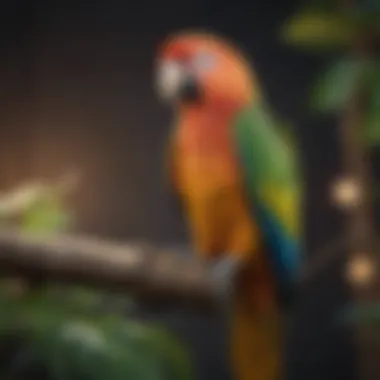
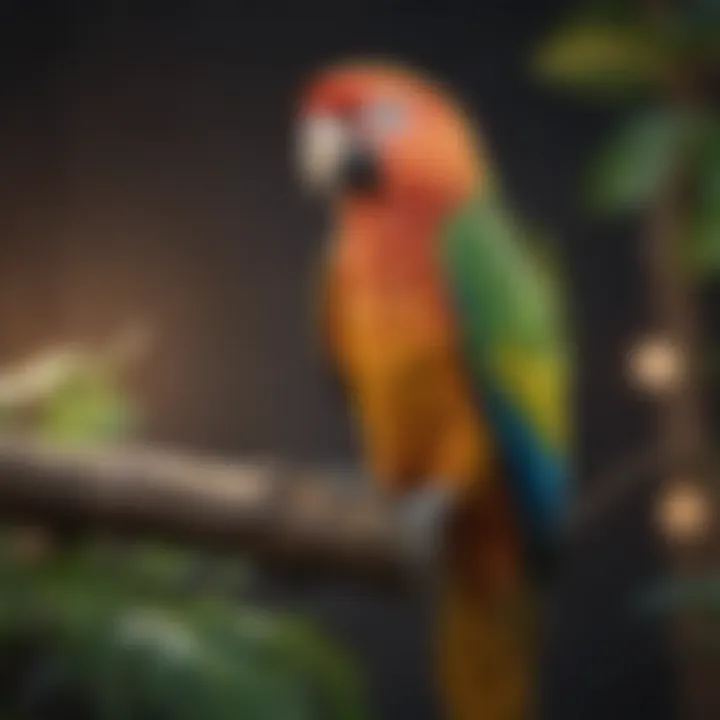
Intro
Pet birds have been captivating companions for many folks around the world, bringing joy and unique personality into homes. It's more than just keeping a bird; it's about understanding the nuances of their care, behavior, and nutrition. This guide aims to bridge the gap between casual bird ownership and more committed avian care.
Whether you're a seasoned bird parent or someone considering bringing a feathered friend into your life, the journey doesn't end at getting a cage and some feed. No, there’s a whole universe to unwrap here.
Birds are not just decorative; they are living, feeling beings that require a genuine commitment of time, effort, and understanding. Many people harbor misconceptions about these creatures, often thinking that their needs are minimal or that they can thrive in isolation. This is far from the truth.
Let’s navigate through the essential aspects of caring for our avian companions, nurturing their well-being, and fostering a bond that can truly enrich both our lives and theirs.
Preamble to Pet Bird Ownership
Owning a bird can be an enchanting journey. For many, the allure lies in the vibrant colors, playful personalities, and the soothing songs of these feathered companions. Yet, stepping into the world of pet bird ownership is not solely about enjoyment. It encompasses a commitment that requires understanding, responsibility, and dedication. This section lays the groundwork for understanding the importance of pet bird ownership and what aspiring bird parents need to consider.
The Allure of Companion Birds
Birds captivate people for various reasons. Their beauty is often the first hook—think of the brilliant plumage of a parakeet or the graceful flight of a canary. There is a certain charm in watching them flit about, expressing their emotions through chirps and whistles. Truly, birds can add life to any household, making them more vibrant and engaging.
Beyond their beauty, birds can form strong bonds with their owners. They have unique personalities that can turn them into delightful companions. Some will sit on your shoulder as you go about your day, quietly observing your activities. Others may engage in playful interactions, learning to mimic sounds or even words. These connections provide companionship that can be deeply rewarding, particularly for those living alone or looking for a lively addition to their home.
The Commitment of Bird Care
However, the charm of having a bird doesn't come without a significant commitment. Understanding the responsibilities involved is crucial for anyone considering bringing a pet bird into their life.
- Time and Interaction: Unlike a goldfish that you can leave to swim alone, many birds thrive on interaction. Regular playtime and social engagement are not just optional; they are vital to their well-being.
- Space and Environment: Birds need adequate space to fly and explore. A small cage is not enough; they require a suitable environment, both physically and socially. This means investing in a proper cage, toys, and safe spaces for them to stretch their wings.
- Health and Nutrition: Proper diet is fundamental. Birds require a balanced selection of seeds, fruits, and vegetables. Knowledge of their dietary needs helps prevent health issues down the line.
- Longevity: Many birds, particularly larger species, can live for decades. This is a long-term commitment, one that should not be taken lightly.
"Owning a pet bird is akin to welcoming a lifelong friend who sings a different tune every day. Recognizing this commitment is essential for a fulfilling relationship."
In summary, as appealing as pet birds can be, prospective bird owners must weigh the responsibilities against the joy they can provide. A well-informed decision leads to a more enriching experience for both the bird and owner.
Types of Pet Birds
When it comes to choosing a feathered companion, knowing the types of pet birds is crucial. Each variety brings its unique character, care needs, and social requirements. Understanding these distinctions helps potential owners make informed decisions and cultivate rewarding relationships with their pets.
Small Birds: Budgies and Canaries
Small birds, particularly budgerigars, commonly known as budgies, and canaries, are beloved by many enthusiasts for a range of reasons. Their petite size makes them suitable for various living situations, like apartments or smaller homes.
Budgies are not only charming but also quite social creatures. Their cheerful chirps fill the home with life, and they thrive on interaction. One notable advantage of owning a budgie is their potential for mimicking sounds and words. This ability not only entertains bird lovers but also stimulates the bird's mental engagement.
Canaries, on the other hand, excel in the area of song. Their melodic tunes can brighten anyone's day and are often considered a point of pride among owners. Possible downsides include that canaries are generally less social than budgies and may prefer solitude. They require specific care, especially about their diet and environment. In brief, small birds are a fantastic choice for those stepping into bird parenting.
Medium-sized Birds: Cockatiels and Lovebirds
Diving into the realm of medium-sized birds, cockatiels and lovebirds exemplify affectionate behavior and active personalities. Cockatiels are often recommended for new bird owners as they are generally easy to care for and extremely social. Their sweet demeanor and ability to whistle make them endearing companions. A cockatiel’s playful antics can keep its owner engaged for hours, elevating the joy of bird ownership.
Lovebirds, as their name suggests, thrive on companionship and are known for their strong bonds with their owners and other birds. They require a bit more attention and social interaction than some other types, making them a fantastic choice for pet owners who can dedicate time to building that connection. These birds can be quite showy with their vibrant hues, drawing admiration from anyone who witnesses their lively nature.
Medium-sized birds can be more demanding in terms of time and social interaction, but the rewards are significant in terms of emotional fulfillment and companionship. Hence, prospective bird owners must consider their lifestyle and willingness to engage actively with these loving creatures.
Large Birds: Parrots and Macaws
When transitioning to larger birds, parrots and macaws take center stage. Parrots, particularly species like African Greys and Amazons, exhibit remarkable intelligence and an ability to form deep emotional bonds. They often keep their owners engaged with their antics and vocal abilities. However, prospective owners must recognize the commitment level required for these birds, as many parrot species can live for decades, some even reaching into their sixties.
Macaws are perhaps the most majestic of the pet birds, featuring brilliant plumage and impressive personalities. They require substantial space, both physically and mentally, making them better suited for dedicated bird owners who can furnish enrichment and social opportunities. Unlike small birds, macaws need significant amounts of interaction, or they may become bored and develop behavioral issues.
These large birds are not for the faint of heart or the casual pet owner. Their housing requirements, diet, and extensive social needs can be a tall order. However, for those ready for the challenge, having a parrot or macaw can be a profoundly rewarding relationship.
Requirements for Bird Care
Caring for pet birds involves more than just feeding them and keeping them in a cage. The Requirements for Bird Care set the stage for a healthy and satisfying life for these avian companions. Proper bird care ensures that they thrive physically and emotionally, with a strong focus on their environment, social needs, and the bond they share with their owners. This section dives into two essential components: their habitat and the social interactions crucial for their well-being.
Habitat and Cage Size
Birds come in various shapes and sizes, and their homes should reflect their unique needs. The size of the cage plays a vital role in their overall happiness. A cramped environment can lead to stress and behavioral issues such as feather plucking. Ideally, a bird's cage should allow them to stretch their wings, hop around, and engage in activities.
When selecting a cage, consider:
- Size: The larger, the better! For a budgie, a cage of at least 18x18x24 inches is a good start, while larger parrots like African Greys need a minimum of 36x24x36 inches.
- Bar spacing: For smaller birds, the bar spacing should be around 1/2 inch to prevent them from escaping or getting stuck. Larger birds can manage with 3/4 inch spacing.
- Material: Opt for durable materials that are easy to clean, such as stainless steel. Avoid plastic that can easily be chewed or harmed.
A clean and enriched habitat enhances a bird's quality of life, promoting health and reducing stress. So, providing a cage that supports their need for space and stimulation is crucial.
Social Environment and Interaction


Birds are inherently social creatures. They thrive in environments where they can interact with others, be it humans or fellow birds. Social interaction is a cornerstone of their emotional well-being. If a pet bird is isolated for too long, it can lead to feelings of loneliness, making them more vulnerable to behavioral problems.
To foster a positive social environment:
- Daily Interaction: Spend time engaging with your bird daily. This might mean talking, singing, or simply being nearby. Birds often come to enjoy their owner's presence.
- Introducing Friends: If possible, consider getting a second bird of the same species. However, whole species must be considered. Not all birds get along, so observe their interactions initially.
- Providing Enrichment: Toys and puzzles can keep them occupied when you can’t be around. Hang toys that they can swing on, chew, or manipulate.
"A happy bird is one that feels part of the family, part of the flock. Make an effort every day to know your feathered friend."
With attentive care and the right living conditions, your pet bird can flourish and become a cherished companion. Investing in their habitat and social needs creates a foundation for a long-lasting relationship filled with joy and companionship.
Nutrition for Pet Birds
Good nutrition is the bedrock of a healthy avian life. Just like us, birds require a well-balanced diet to thrive. Without proper nourishment, even the most lively and colorful pet birds can face a myriad of health issues. Feeding your feathered companion right can mean the difference between vibrant plumage and dull feathers, active chirping or sad silence. The right nutrition aids in better moods, longer lifespans, and clearer vocalizations. It’s crucial to understand what constitutes a balanced diet for different species of pet birds, as each has its own specific needs.
Understanding Avian Diets
When we think about feeding birds, one usually pictures seeds and maybe some pellets. However, that’s just scratching the surface. Pet birds’ diets are quite varied, encompassing a wide range of food types. Generally, their diet should consist of:
- Seeds: These form the staple for many pet birds, particularly for smaller species. Yet they shouldn't dominate their diet. Fresh seeds, that are pesticide-free and organic, are a must for healthy birds.
- Pellets: These offer a balanced mix of nutrients, vitamins, and minerals, tailored to birds' needs. However, not all pellets are created equal. Research is key; find reputable brands that prioritize avian health.
- Fruits and Vegetables: Fresh produce can significantly enhance birds' diets. Leafy greens such as kale, dark leafy lettuce, and herbs like basil usually provide essential nutrients. Fruits like apples, bananas, and berries often make birds' eyes light up, offering a tasty treat as well.
- Grains: Quinoa, oats, and barley can add variety and texture to a bird's menu, supporting their digestive health.
- Protein Sources: Periodic servings of cooked eggs and legumes can aid in muscle development and overall health.
Birds can be picky eaters, so you might need to present food in creative ways to entice them. Mixing textures can keep things interesting for your bird.
Common Dietary Mistakes
Many pet bird owners make dietary choices that impact their birds' well-being negatively. Here are points to consider:
- Over-reliance on Seeds: While seeds might seem tempting, they often lack necessary vitamins and can lead to obesity. A seed-only diet is a big no-no.
- Neglecting Fresh Foods: It’s easy to forget to provide fresh fruits and veggies amid busy lives. Yet, they are crucial for delivery of essential nutrients.
- Ignoring Water Quality: Clean, fresh water is vital, yet many skip changing it daily. Always check the water for any contaminants.
- Human Food: Not all food that humans eat is healthy for birds. High-fat and salty foods can be harmful. Avoid giving your bird anything from your plate without checking its safety first.
- Underestimating Needs Based on Size: Smaller birds and larger birds have distinct dietary needs. For instance, while a cockatiel can thrive on a mix of seeds and pellets, a parakeet’s diet should be more focused on vegetables.
"Birds are what they eat, just like us. Making informed food choices will pave the way for a happier, healthier bird."
Navigating the world of bird nutrition can feel overwhelming, particularly with all the conflicting information available. However, keeping informed and regularly checking in on your pet's dietary habits can go a long way in ensuring your feathery friend lives a long, healthy, and happy life. Ensuring a balanced diet will not only improve your pet’s well-being but also enrich the bond you share.
Behavioral Insights
Understanding the behavior of pet birds is crucial for their well-being and happiness. Birds, much like humans, have unique personalities and ways of expressing themselves. Recognizing their behaviors can enhance the bond between owners and their feathered comrades.
Behavioral insights help owners create a nurturing environment tailored to their pet's needs. By being aware of common behaviors, pet owners can anticipate issues before they escalate, ensuring a happier life for both the bird and the human involved. This section aims to illuminate essential behavioral aspects that every bird parent should understand and consider during their journey.
Understanding Body Language
Birds communicate a lot through body language. Unlike dogs or cats, their subtle cues can be tricky for a newbie to read. Interests can shift like the breaze, so it's essential to watch for signs of comfort or stress. For instance, when a bird is relaxed, it may fluff up its feathers or perch with its head tucked under its wing. Conversely, if they feel threatened, the feathers may bristle, making them appear larger.
Some specific signs include:
- Tail Position: A tail that’s held low could mean calmness, whereas a raised or flared tail often indicates excitement or aggression.
- Head Bobbing: This can be a friendly gesture or an instinctual response. Notice the context and repetition of the action.
- Puffed Up Feathers: This often shows they are feeling warm or cozy, but it could also indicate illness if prolonged.
"Reading your bird's body language is as essential as knowing how to feed them. The more you understand their cues, the stronger the bond you'll have."
Social Interactions with Humans
Birds are inherently social creatures; they thrive on interactions. Building rapport with your pet bird can lead to an exciting and fulfilling companionship. Birds have their own preferences regarding how they like to interact with humans. Some may enjoy being handled and cuddled, while others prefer a more independent relationship where they come for attention on their own terms.
To best foster social interactions:
- Respect Their Space: Just because you want to play doesn’t mean the bird is interested. Give them options.
- Talk to Them: Using a soothing voice can help make them feel secure. They might even mimic you eventually!
- Consistent Routine: Birds, like kids, do well with structure. Regular interaction times can help reduce anxiety and encourage bonding.
- Observe Their Reactions: Pay attention to how they respond during different interactions. Adjust your approach based on their feedback.
Cleaning their cage or providing fresh food often becomes an opportunity for interaction. Use those moments wisely, and they could love being part of your daily routine rather than just a chore.
Health and Wellness
Birds, much like any other pets, require substantial attention to their health and well-being. Understanding the various aspects of avian health is central for any bird owner as it not only extends the life of the bird but also ensures that they thrive in a nurturing environment. Since birds often hide symptoms of illness, the responsibility lies heavily with the owner to recognize signs of health or distress. Overall, healthy birds are typically more engaging companions, which heightens the reward of pet ownership.
Signs of a Healthy Bird
Being able to identify a healthy bird is the first step in maintaining its well-being. Observing physical health indicators can provide vital insight into your bird’s overall condition:
- Bright, alert eyes: A healthy bird tends to be bright-eyed and attentive, showing a keen interest in its surroundings.
- Smooth feathers: The plumage should be smooth, without any irregularity. A bird that frequently fluffs up its feathers may be feeling uncomfortable or unwell.
- Active behavior: Healthy birds show eagerness to explore and interact. If your pet spends too much time lethargically perched, that could be grounds for concern.
- Clean beak and claws: A well-maintained beak that isn’t overgrown and clean claws are good signs of health.
- Normal droppings: Droppings should be well-formed and consistent in color. Sudden changes in droppings can indicate potential health issues.
"If your feathered friend reflects a vibrant demeanor, you’re likely on the right path in their care!"
Monitoring these markers daily can help in catching any potential health issues early, thus allowing for timely intervention.
Common Health Issues
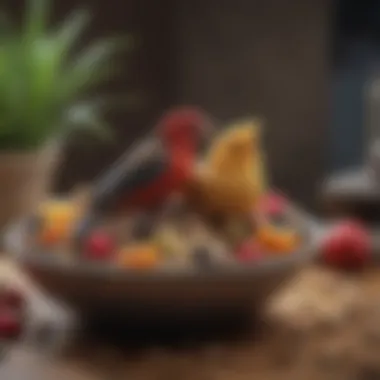
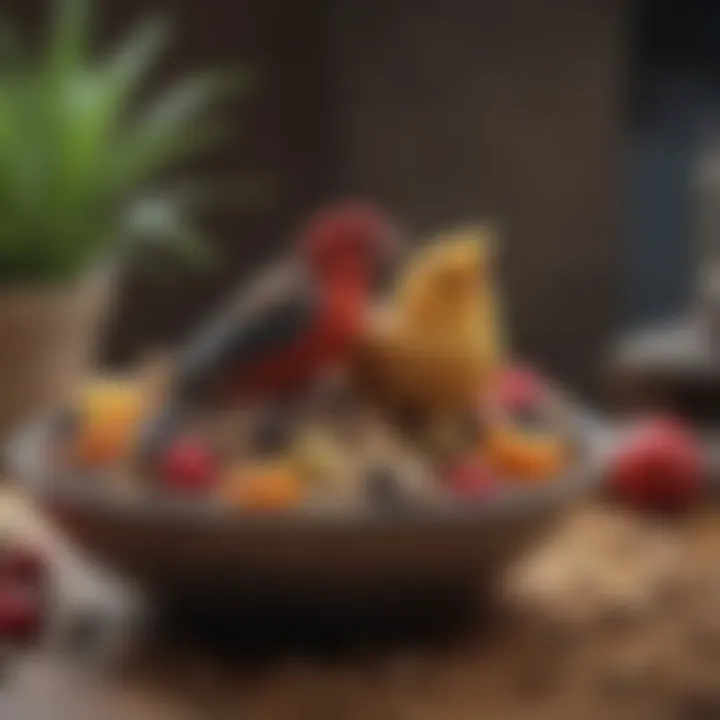
When it comes to avian health, knowledge about common ailments can be quite invaluable for pet bird owners:
- Feather Plucking: This compulsive behavior often arises from stress or boredom. It’s important to address environmental enrichment because it can lead to wounds and infections if left untreated.
- Respiratory Issues: Symptoms like wheezing, rapid breathing, or nasal discharge can indicate serious trouble requiring immediate veterinary attention.
- Obesity: Many pet birds lead a sedentary lifestyle, leading to weight gain. An increase in body weight can dramatically affect their health.
- Gastrointestinal Disorders: Gastro problems can lead to changes in droppings or decreased appetite. Monitoring for abnormal behavior is key in preventing these issues.
Understanding these common health pitfalls will better prepare you as an owner, aiding in the prevention or detection of issues.
Preventative Care Strategies
Preventative care can save a bird from potential pain and discomfort down the line. Here are some effective strategies to consider:
- Regular Veterinary Check-ups: Just like humans, birds benefit from routine check-ups. An avian vet can catch conditions before they become serious.
- Balanced Diet: Ensuring a nutritious diet rich in fruits, vegetables, seeds, and pellets provides the foundation for a healthy bird. Avoiding excessive treats and ensuring variety can keep nutritional balance in check.
- Intellectual Stimulation: Engaging your bird with toys, puzzles, and human interaction can stave off behavioral issues. This is often as important as physical care.
- Clean Environment: Keeping the bird’s cage clean and sanitized is essential. Regularly changing food and water, and cleaning up droppings can prevent diseases.
By weaving these strategies into your daily care routine, your feathered friend will not only live longer but may also enjoy a better quality of life.
Environmental Enrichment
Creating an enriching environment for pet birds is more than just a luxury; it’s essential for their mental and physical well-being. Birds, being intelligent creatures, require stimulation to keep them engaged and happy. Without proper environmental enrichment, these birds can become bored or depressed, which often manifests in destructive behaviors. The concept of environmental enrichment is all about enhancing the habitat of birds to encourage natural behaviors, thus improving their quality of life.
When you think of enrichment, you might picture a cage filled with toys, but it goes beyond mere playthings. Environmental enrichment encompasses a variety of factors—habitat design, sensory stimulation, and opportunities for physical exercise. Here are some specific elements to consider:
- Diverse Habitats: The layout of the cage or aviary should mimic the natural environments of the bird species you own. For instance, adding branches of different sizes for climbing and perching not only facilitates exercise but also allows birds to express natural behaviors like foraging.
- Visual Stimulation: Birds are often drawn to colorful objects. Incorporating a variety of visually stimulating items, like multicolored toys, can pique their interest and improve their mood. Mirrors, hanging decorations, or even a window view can offer breaking views into their surroundings.
- Sound Environment: Many birds communicate through sounds, and a lively soundscape can be beneficial. Provide opportunities for auditory enrichment by including toys that produce chirps, bells, or even softly playing music.
The overall goal of environmental enrichment is to create a stimulating abode that mirrors the natural habitat of birds. This is not just for fun—it has real benefits:
- Reduces Stress: A well-enriched environment can help minimize stress levels among birds.
- Prevents Behavioral Problems: Engaged birds are less likely to engage in unproductive or harmful behaviors such as excessive screaming or feather plucking.
- Promotes Healthy Activity Levels: With varied opportunities for physical activity, your bird is likely to remain fit and healthy.
"An enriched environment empowers your birds, keeping them active and engaged. It’s the heart of responsible bird ownership."
By understanding the elements of environmental enrichment, you can better cater to your feathered friends, ultimately leading to happier and healthier pets.
Toys and Activities
Toys are pivotal in the life of a pet bird, serving as both entertainment and learning tools. Different birds have different preferences, so it’s important to offer a variety of toys that cater to different interaction styles. Here are some types of toys:
- Chewing Toys: Birds naturally have a need to chew, so providing wooden blocks, cardboard, or coconut shells can satisfy this urge. Chewing also helps maintain their beaks.
- Foraging Toys: These encourage natural foraging behaviors. Toys that hide treats or require the bird to solve a puzzle to get to the reward are especially beneficial.
- Climbing Toys: Adding ropes or ladders can help keep your bird physically active, encouraging them to explore and exercise more.
Each activity a bird engages in brings learning opportunities, which is vital for their cognitive health. Choosing appropriate toys means observing your bird’s behavior and making adjustments, creating a space that feels safe and fun for them.
Mental Stimulation Requirements
Birds are not just pretty faces—they are intelligent beings that require mental engagement. Cognitive challenges help to mimic the complexity of their natural habitats. To ensure your bird receives enough mental stimulation, consider the following:
- Interactive toys that require problem-solving, such as treat-dispensing puzzles.
- Training sessions can also serve as excellent mental exercises. Birds thrive on learning and mastering new tricks or commands, fostering a stronger bond between owner and bird.
- Social Interaction : Spending time chatting or playing with your bird every day also stimulates their minds and fosters emotional bonds.
Implementing these mental challenges creates a fulfilling life for your bird, boosting their confidence and happiness levels. In essence, when birds utilize their brains, they flourish, leading to a sense of contentment and reduced anxiety.
The Role of Socialization
Socialization is what makes your pet bird feel at home in its surroundings. Unlike cats or dogs, birds are exceptionally social creatures that thrive on interaction, both with their human companions and other birds. A well-socialized bird tends to exhibit better behavior, enjoys a higher quality of life, and, quite frankly, just seems happier. The foundation of a strong bond involves meeting their social needs and understanding their behaviors.
It's not all about cuddles and treats; socialization is also about establishing trust. Birds can be skittish, and exposing them to various environments and sounds is crucial. This exposure helps create an adaptable and stress-free pet. Furthermore, socializing contributes to their cognitive development, encouraging them to explore and play—activities that keep their minds sharp and engaging.
Introducing New Members to the Flock
Bringing in new members, whether they are people or birds, requires thoughtfulness. Birds are often territorial and can become quite defensive of their space when they sense a newcomer. Gradual introductions are essential. Start by allowing your existing bird to see and hear the new member from a distance. This could be through a safe barrier or while in separate rooms.
Once they seem comfortable, step up the interactions. Let the new person offer treats from afar. Here are some key points for smoother introductions:
- Observe body language: Pay attention to the postures and sounds of your birds. Noticing changes can give you clues on how they feel.
- Use gradual exposure: Allow them to explore spaces where they won't feel encroached upon.
- Maintain routine: Birds thrive on predictability, so ensure their daily schedule remains as unchanged as possible during the introduction phase.
If you're introducing a new bird, consider the age and species compatibility. Birds like cockatiels often get along well with other small to medium birds, while larger species might not.
Birds and Other Pets
It can be a tricky business introducing a bird into a household full of other pets. Dogs and cats, in particular, are hunters by nature, and having a bird in their sight might kick their instinct into gear. Careful management is needed to ensure safety and comfort. Here are some pointers:
- Supervised Introductions: Always keep initial interactions supervised. Never trust a cat or a dog alone with a bird, regardless of how well they behave.
- Create Safe Spaces: Ensure your bird has a secure area where it can retreat if it feels threatened.
- Positive Reinforcement: Reward your dogs or cats for calm behavior when around the bird; this can help for them to associate birds with a positive experience.
Training Your Pet Bird
Training your pet bird is not just a fun pastime; it’s a crucial element of responsible bird ownership. By instilling a set of commands and tricks, you not only enhance the interaction you have with your feathered friend but also foster a harmonious living environment. Training can lead to benefits such as improved social behavior, reduced stress levels, and a deeper connection between you and your bird.
Basic Commands and Tricks
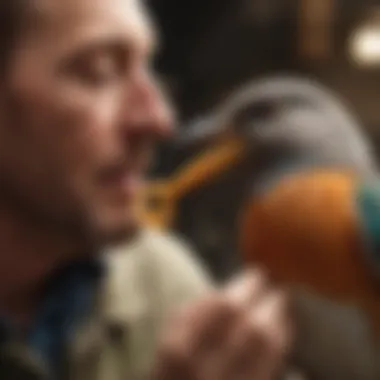
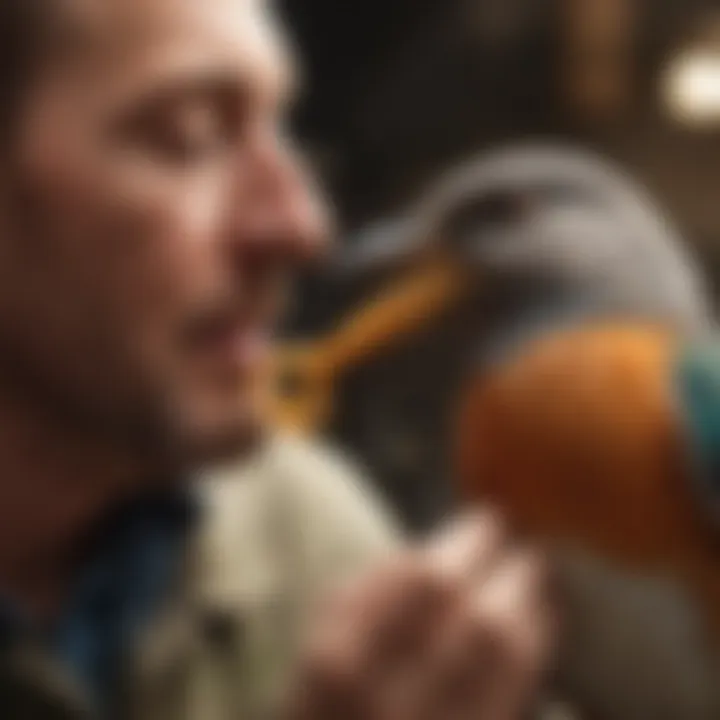
Starting with basic commands can set the stage for a rewarding relationship with your bird. These commands, such as "come," "step up," and "quiet," form the foundation of good behavior. The use of positive reinforcement—like treats or affection—can motivate your bird to learn and solidify these commands. Here are a few tips to get started:
- Create a Quiet Space: Choose an area free from distractions, allowing your bird to focus on your commands.
- Short Sessions: Keep training sessions to 5-10 minutes, as birds have relatively short attention spans.
- Consistency is Key: Use the same words and gestures every time to avoid confusing your bird.
A common trick to teach is to have your bird "step up" onto your finger. Once your bird is comfortable, gradually introduce new tricks, perhaps even using objects like small hoops or perch swings to encourage engagement. It's crucial to remember that patience is your best ally in training. Birds can pick up tricks relatively quickly, but your expectations must remain realistic.
Addressing Behavioral Problems
Every bird has its unique personality, and with that comes a set of behaviors that may be challenging for owners. Identifying and addressing these behaviors early is crucial to ensure a peaceful cohabitation. Common behavioral issues include excessive squawking, biting, or fear of certain actions. Here’s how to tackle some problems:
- Excessive Vocalization: Sometimes, birds get noisy when they feel lonely or bored. Increasing interaction or providing stimulating toys can mitigate this.
- Biting: A bird may bite as a form of defense or fear. Understand the body language preceding biting and respect your bird’s personal space. Give them time to adjust.
- Fear: New environments or changes can make birds uneasy. Gradually introduce any new elements, offering them time and space to adapt.
Essentially, managing behavior also ties back to proper environmental enrichment and socialization that were discussed in previous sections. The more comfortable and secure your bird feels, the more successful your training efforts can be.
Adopting Versus Purchasing a Bird
The choice between adopting and purchasing a pet bird is more than just a matter of preference; it’s a decision laden with ethical considerations and practical implications. Both approaches come with their own sets of challenges and rewards, which can influence the life of a bird and its new owner significantly. When considering this choice, factors such as the bird's background, your lifestyle, and long-term commitment to avian care need to be well thought out.
Considerations for Adoptions
Adopting a bird often allows individuals to provide a loving home for those in need. Many birds end up in shelters due to unforeseen circumstances like changes in ownership or owner health issues. Adopting gives these creatures a second chance at a happy life. Here are some aspects to think about before deciding to adopt:
- Personal Compatibility: Each bird has its own personality. Visit shelters to interact with different birds and find one that fits your temperament.
- History of the Bird: Understanding a bird's past can be essential. Some may come with baggage—traumas from earlier experiences that can affect behavior.
- Cost: Initially, adopting is often less expensive compared to purchasing. Adoption fees typically include vaccinations and sometimes even a starter kit.
- Variety of Choices: Shelters may have a range of species, from conures to cockatoos, giving adopters diverse options.
Adopting is a life-altering decision and many birds have so much love to give.
"Every bird deserves a home. Adopting can be the best choice for both you and your feathered friend."
Ethics of Pet Bird Purchase
On the other hand, purchasing a bird often raises ethical questions pertaining to the sources of those birds. Many commercial breeders prioritize profit over the welfare of the birds, which can lead to less than ideal living conditions. Responsible breeding practices do exist, but potential owners must do their research diligently. When considering purchasing a bird, pay attention to the following factors:
- Reputable Breeders: Not all breeders have the bird's best interest at heart. Look for breeders that prioritize health, welfare, and proper socialization. Ask about their practices, facilities, and how they treat their birds.
- Bird's Origin: Knowing where your bird comes from is essential. Wild-caught birds may face different challenges, while those bred in captivity often have better chances at forming bonds with humans.
- Health Guarantees: Quality breeders often provide health guarantees and initial health checks. This is something crucial that can save a lot of trouble down the line.
- Lifecycle Commitment: Understand that purchasing a bird typically means committing to its life cycle, which can range from 10 years for smaller species up to 80 years for larger ones.
Purchasing a bird can be ethically sound if done thoughtfully. Just as with adopting, you’re committing to a being that requires care and attention.
In summary, whether adopting or purchasing a bird, the central idea is to ensure that the choice you make benefits both you and the bird in the long run. The commitment to providing an enriching and loving environment doesn’t change, regardless of how you find your feathered companion.
Legal Considerations
When it comes to owning pet birds, legal considerations are more important than many enthusiasts might think. Understanding the laws surrounding bird ownership is crucial for both the wellbeing of your feathered companions and ensuring that you stay within legal boundaries. Legal issues can range from local regulations to national laws that protect certain species of birds. In an era where wildlife conservation is at the forefront, understanding these laws is key.
Understanding Avian Laws
Avian laws vary widely depending on your location. Some birds are protected by specific legal frameworks, aiming to conserve their populations in the wild. For instance, many exotic birds fall under various regulations, such as the Migratory Bird Treaty Act in the United States, which protects over 800 species from hunting and capture without the necessary permits.
An essential point to note is that not all birds are created equal in the eyes of the law. Certain exotic species may require special licenses to own. Failing to comply can lead to significant legal repercussions. It’s advisable for bird owners to research not only their local laws but also state and federal regulations applicable to their birds. Doing so ensures that you foster a passion for pet birds without inadvertently breaking the law.
"Knowing the legal landscape can be just as crucial as understanding your birds' needs."
Permits and Regulations
In addition to grasping avian laws, understanding specific permits and regulations is vital. Many states require permits for the ownership of certain species, particularly those that are rare or endangered. These permits are often aimed at promoting responsible pet ownership and wildlife conservation efforts.
Here are some common points to consider regarding permits:
- Ownership Limits: Some laws impose limits on the number of birds you can own based on their species and whether they are classified as endangered.
- Hatching and Breeding Permits: If you plan to breed your birds, check whether you need additional permits for hatching eggs or selling chicks.
- Transport Regulations: If you’re traveling with your bird, be aware of transport regulations that may apply, particularly if crossing state lines or international borders.
While it may seem daunting, being informed about permits not only protects your legal rights but also contributes to the responsible management of bird species. In the long run, this can help in reducing the risk of avian diseases and support efforts toward wildlife conservation. By taking the time to understand the nuances of bird ownership laws, you not only safeguard your hobby but also enhance your understanding of, and commitment to, responsible bird care.
Culmination
As this guide has intricately woven through the various aspects of pet bird ownership, it becomes clear how crucial a synthesis of knowledge, responsibility, and enthusiasm is for anyone venturing into this avian realm. The relationship between bird owners and their feathered companions is not merely a pastime; it is a profound commitment that revolves around understanding their unique behaviors, dietary needs, and health concerns. Each section offered a blend of insights that inspires diligent care and appreciation for these remarkable creatures.
Summarizing Key Insights
Throughout this journey, several key insights have emerged that deserve emphasis:
- Diversity of Species: Whether you lean towards the joyous chatter of budgies or the majestic presence of macaws, understanding the wide variety of pet birds available allows for informed choices, ensuring that owners select a species that aligns with their lifestyle and expectations.
- Care Requirements: From adequate living environments to nutritional needs, the essential aspects of bird care were outlined to stress that they require more than just a cage and food. They thrive in engaging habitats, where mental and physical stimulation is paramount.
- Behavioral Understanding: Recognizing bird behaviors, whether it's their body language or vocalization habits, opens a pathway to better communication and strengthens the bond between human and bird. This insight lays the foundation for a positive relationship.
- Health Vigilance: Owners must remain observant regarding their birds' health, recognizing signs of well-being versus indicators of distress. Preventative strategies, like regular check-ups, play an invaluable role in ensuring longevity and quality of life.
These insights come together to create a tapestry of knowledge that not only fosters better bird care but also nurtures an enriching experience for both parties. Bird ownership isn’t simply about having a pet; rather, it is about creating a nurturing environment where both bird and owner can flourish.
Encouraging Responsible Bird Care
Fostering responsible bird care goes beyond adhering to a checklist of requirements. It encompasses a mindset rooted in understanding and respect for the animal as a companion. Here are some key considerations:
- Commitment to Lifelong Care: Birds, depending on species, can live for decades. Prospective owners must prepare for a long-term relationship that includes all manner of care from basic needs to specialized attention as health issues arise with age.
- Continuous Learning: The avian world is ever-evolving with new research and discoveries. Staying informed not just about a specific species but also about general bird welfare broadens an owner’s ability to provide the best care.
- Community Engagement: Engaging with fellow bird lovers through forums like reddit.com or groups on facebook.com can provide support, ideas, and feedback. Such connections can enhance one’s learning curve and enjoyment of bird ownership.
- Ethical Considerations: Whether adopting or purchasing a bird, ethical considerations—such as sourcing from reputable breeders or shelters—should be paramount in the decision-making process. This illustrates a commitment to not only care for one’s animal but to contribute to a larger community of responsible pet ownership.
In closing, understanding pet birds is a multifaceted endeavor that requires both knowledge and emotional investment. The insights granted by this guide serve as a stepping stone. For both novice and seasoned bird enthusiasts, the journey does not end here; it expands into a realm of nurturing, respect, and shared experience with our feathered friends.















